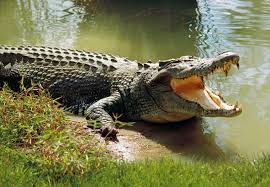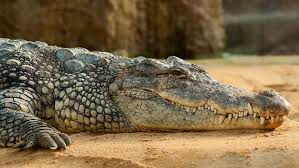The Gharial (Gavialis gangeticus) is a fascinating creature, venerated as a unique gem in the realm of biodiversity. This species of crocodile, indigenous to the Indian subcontinent, is known for its distinctive elongated, narrow snout and a myriad of needle-like teeth, features that have evolved specifically for a fish-based diet. Its exceptional adaptation and unique visual appeal, coupled with its endangered status, make the Gharial a subject of considerable interest for both the scientific community and wildlife enthusiasts globally.
Conservation Status
- Endangered (EN): A species is considered endangered when it faces a very high risk of extinction in the wild in the near future.
- Vulnerable (VU): A species is classified as vulnerable when it is not critically endangered or endangered but is facing a high risk of extinction in the wild in the medium-term future.
- Near Threatened (NT): A species is near threatened when it has been evaluated and does not qualify for critically endangered, endangered or vulnerable now, but is close to qualifying for or is likely to qualify for a threatened category in the near future.
- Least Concern (LC): A species is categorized as least concern when it has been evaluated but does not qualify for any other category. Such species are widespread and abundant in the wild.
- Extinct (EX): A species is termed extinct when there is no reasonable doubt that the last individual has died.
Distribution
- Broad Reach: Distribution strategies allow businesses to reach a wide range of customers across various geographical locations. It enables products and services to be available to potential customers at the right place and at the right time.
- Customer Satisfaction: Effective distribution ensures that customers have easy access to a company’s products or services, enhancing their overall experience and satisfaction.
- Competitive Advantage: A well-planned distribution network can give a business a significant edge over its competitors by ensuring more efficient delivery and better availability of products or services.
- Increased Sales: By making products or services readily available in multiple locations, businesses can increase their sales potential and drive revenue growth.
- Brand Visibility: Distribution also plays a crucial role in increasing brand visibility and recognition, thereby helping in building brand loyalty among customers.
Characteristics, Habitat, and Behavior
- Characteristics: The grey wolf is a highly adaptable species that can vary greatly in size, generally depending on its geographical location. They have dense fur that can range in color from pure white to solid black, which helps them survive in diverse climates.
- Habitat: Grey wolves inhabit a wide array of ecosystems, from arctic tundra to forests, grasslands, and deserts. They have the largest range of any land mammal, barring humans.
- Behavior: Grey wolves are social creatures, living and hunting in packs that can range from small family units to groups of 20 or more. Their complex social structures include a hierarchy with dominant leaders and submissive followers. They communicate using a variety of vocalizations, body postures, and scents.
Feeding Habits
- Carnivores: Animals who primarily feed on other animals. They have sharp teeth and claws to capture and kill their prey.
- Herbivores: These creatures mainly consume plant material. They have specially adapted teeth and digestive systems to break down tough plant fibers.
- Omnivores: Animals that have a diet consisting of both plant and animal sources. They have a combination of sharp front teeth for tearing meat and flat molars for grinding plant material.
- Insectivores: These animals have diets that predominantly include insects. They possess sharp, pointed teeth to capture and consume their prey.
- Frugivores: Animals that primarily feed on fruits. They play a crucial role in seed dispersal, ensuring biodiversity.
Related Post: Gharial Chronicles: Ancient Beauty in Modern Waters
Major Threats
- Climate Change: The rise in global temperatures, caused predominantly by the burning of fossil fuels, is leading to melting ice caps, rising sea levels, and more frequent and severe weather events that pose significant threats to both human and natural systems.
- Loss of Biodiversity: The accelerated extinction of animal and plant species due to habitat destruction, overexploitation, pollution, and other human activities, is disrupting ecosystems and their functions, which could have dire consequences for life on Earth.
- Plastic Pollution: The excessive use and improper disposal of plastic products result in immense pollution, particularly in our oceans, harming marine life and entering the human food chain.
- Deforestation: Large-scale cutting down of forests for agriculture, logging, and urbanization is leading to a loss of habitats, reduction in carbon dioxide absorption, and contributing to climate change.
- Water Scarcity: Overuse and pollution of water resources, coupled with climate change, is leading to a scarcity of clean, accessible water, endangering human health and agriculture.
Conservation Efforts
- Preservation of biodiversity: Conservation efforts play a significant role in preserving biodiversity. Protecting natural habitats helps to maintain the balance of ecosystems, ensuring the survival of a diverse array of plant and animal species.
- Reduction of global warming: Conservation initiatives often involve reforestation and afforestation projects, which aid in the sequestering of carbon dioxide, consequently mitigating the impacts of global warming.
- Sustainable use of resources: Conservation encourages the sustainable use of natural resources, ensuring that future generations can enjoy and benefit from these resources.
- Cultural preservation: Many indigenous cultures are closely tied to their natural environment. Therefore, conservation efforts often contribute to the preservation of cultural heritage.
- Economic benefits: Healthy ecosystems provide numerous economic benefits, from tourism revenue to ecosystem services such as pollination and natural disaster mitigation.
Conclusion
- Consistent engagement in outdoor activities significantly contributes to overall health, fostering both physical strength and mental resilience.
- Actively participating in such pursuits can lead to improved cardiovascular health, muscle toning, and enhanced endurance.
- Beyond the physical benefits, outdoor activities also serve as a stress reliever, promoting mental well-being by reducing anxiety and depression.
- Embracing the outdoors also stimulates a sense of connection with nature, fostering mindfulness and a sense of peace, which is beneficial for emotional health.




